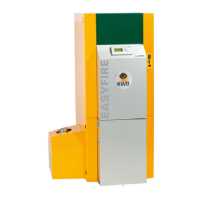7 Flue gas measurement
7.1.4 Information on carbon dioxide (CO
2
)
• Unit: %, to be more precise: Percentage by volume based on the dry flue gas
• Occurs each time carbon is combusted (even when breathing, approximately 3 %), plant nutrient, greenhouse
gas
• Odourless and colourless gas, non-toxic but asphyxiating
•CO
2 also occurs naturally when wood is burned. However because it is used again in the same year by growing
trees the greenhouse effect is not increased
• Maximum value when burning wood (CO
2 max): 19.4 %
•The CO
2 content should be between 10 and 11.5 %
• Values above 14 % (lack of air) cause boiler soot
• Values under 9 % result in low efficiency, with damp fuel they result in low combustion temperatures.
7.1.5 Residual oxygen (0
2
)
• (Residual) oxygen: Remains after combustion
• Unit: %, to be more precise: Percentage by volume based on the dry flue gas
• Is required for all combustion and for every life process (breathing, decomposition)
• Odourless and colourless gas, total combustion in pure O
2
• Air has an O2 content of 21 %
•The O
2
content can be calculated directly from the CO
2
:
%O
2
= 21 – %CO
2
7.1.6 Air ratio number
• Ratio of combustion air quantity to the minimum air requirement
• The minimum air requirement for combustion is the minimum air quantity that theoretically is required for
combustion of a fuel (CO
2 = 21 %, λ = 1)
• The air ratio λ should be between 1.9 and 2.3.
• The air ratio can be directly calculated from the O
2 content or the CO2 content:
λ = 21/ %CO = 21/(21– %O
2)
7.1.7 Carbon monoxide (CO)
• Units: ppm, mg/Nm³ at 13 % O2, mg/MJ
• CO occurs if there is incomplete combustion of carbon due to a lack of oxygen, or combustion temperatures
that are too low
• Odourless and colourless gas
• Blocks transport of oxygen in the blood (death due to gas, flue gas poisoning)
MA-Easyfire 10.2008_EN.indd 74MA-Easyfire 10.2008_EN.indd 74 30.03.2009 13:30:12 Uhr30.03.2009 13:30:12 Uhr

